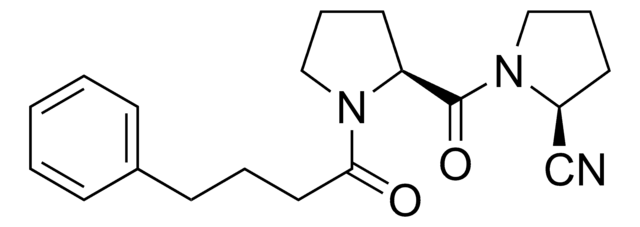SML0205
Z-Pro-prolinal
≥98% (HPLC)
Synonym(e):
Cbz-Pro-Prolinal, N-Benzyloxycarbonyl-L-prolyl-L-prolinal, Phenylmethyl (2S)-2-[(2S)-2-formylpyrrolidine-1-carbonyl]pyrrolidine-1-carboxylate, Z-Pro-Pro-CHO, Z-PP-CHO, Z-pro-pro-CHO, Z-prolyl-prolinal, ZPP
About This Item
Empfohlene Produkte
Assay
≥98% (HPLC)
Form
powder
Lagerbedingungen
desiccated
Farbe
white to tan
Löslichkeit
DMSO: ≥10 mg/mL
Lagertemp.
−20°C
InChI
1S/C18H22N2O4/c21-12-15-8-4-10-19(15)17(22)16-9-5-11-20(16)18(23)24-13-14-6-2-1-3-7-14/h1-3,6-7,12,15-16H,4-5,8-11,13H2/t15-,16-/m0/s1
InChIKey
ORZXYSPOAVJYRU-HOTGVXAUSA-N
Anwendung
Biochem./physiol. Wirkung
POP has been connected to memory and mood through regulation of the brain levels of its peptide substrates, which include AVP, substance P, neurotensin and TRH and is a potential target in cognitive function, memory, and neurodegenerative disorders such as amnesia, Alzheimer′s disease, and depression. POP has recently been reported to be involved in the release of the tetrapeptide acetyl-N-Ser-Asp-Lys-Pro (Ac-SDKP) from its precursor, 43-mer thymosin β4 (Tβ4). Ac-SDKP is involved in hemopoietic stem cell differentiation, is pro-angiogenic and antifibrogenic.
Signalwort
Warning
H-Sätze
Gefahreneinstufungen
Acute Tox. 4 Oral - Eye Irrit. 2
Lagerklassenschlüssel
11 - Combustible Solids
WGK
WGK 3
Flammpunkt (°F)
Not applicable
Flammpunkt (°C)
Not applicable
Analysenzertifikate (COA)
Suchen Sie nach Analysenzertifikate (COA), indem Sie die Lot-/Chargennummer des Produkts eingeben. Lot- und Chargennummern sind auf dem Produktetikett hinter den Wörtern ‘Lot’ oder ‘Batch’ (Lot oder Charge) zu finden.
Besitzen Sie dieses Produkt bereits?
In der Dokumentenbibliothek finden Sie die Dokumentation zu den Produkten, die Sie kürzlich erworben haben.
Kunden haben sich ebenfalls angesehen
Artikel
We offers many products related to neuropeptidases for your research needs.
Unser Team von Wissenschaftlern verfügt über Erfahrung in allen Forschungsbereichen einschließlich Life Science, Materialwissenschaften, chemischer Synthese, Chromatographie, Analytik und vielen mehr..
Setzen Sie sich mit dem technischen Dienst in Verbindung.










